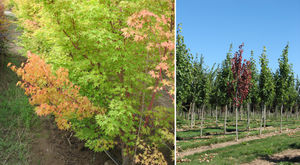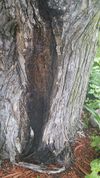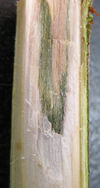Verticillium Wilt: Difference between revisions
No edit summary |
No edit summary |
||
| Line 1: | Line 1: | ||
[[file: Vertfigure4composite.jpg|thumb|right|Japanese Maple (Right) and Red Maple (Left) with premature fall coloring due to Verticillium Wilt[1].]] | [[file: Vertfigure4composite.jpg|thumb|right|Japanese Maple (Right) and Red Maple (Left) with premature fall coloring due to Verticillium Wilt[1].]] | ||
Verticillium wilt is the result of a soil-borne fungal pathogen called ''Verticillium dahliae'' that infects over 200 species of plants[1]. In all there are ten recognized species of ''Verticillium'' but ''V. dahliae'' has the widest range of hosts. These can include, maple trees, tomato plants, eggplants, peach trees, black raspberry, spinach, pumpkin, alfalfa, hops, cherry trees, peony, snapdragons, chrysanthemums, etc[1]. As said there are over 200 species that acts as a host, many of which include many important agriculture crops, or forest species. | Verticillium wilt is the result of a soil-borne fungal pathogen called ''Verticillium dahliae'' that infects over 200 species of plants[1]. In all there are ten recognized species of ''Verticillium'' but ''V. dahliae'' has the widest range of hosts. These can include, maple trees, tomato plants, eggplants, peach trees, black raspberry, spinach, pumpkin, alfalfa, hops, cherry trees, peony, snapdragons, chrysanthemums, etc[1]. As said there are over 200 species that acts as a host, many of which include many important agriculture crops, or forest species. | ||
''V. dahliae'' belongs to the ascomycota genus of fungi, more commonly known as sac-fungi[9]. Ascomycota can reproduce sexually and asexually, however ''V. dahliae'' reproduce asexually though conidia[9]. | |||
=Signs and Symptoms= | =Signs and Symptoms= | ||
| Line 14: | Line 16: | ||
''V. dahliae'' exists in three life stages; dormant, parasitic, and saprophytic. | ''V. dahliae'' exists in three life stages; dormant, parasitic, and saprophytic. | ||
====Dormant==== | ====Dormant==== | ||
In its dormant phase, mycelia and microsclerotia (dark, durable, resting structures produced by the fungus[8])of the fungus are capable of surviving in dried conditions, they can survive in soil away from a host or embedded in fragments of tissue[6]. The structures will be ready to germinate once in the presence of a host[7]. The microsclerotia can either stand alone, become embedded in plant leaves or branches; once the branches or leaves die and fall off the tree they can be transported by wind to other places[3]. Because microsclerotia allow verticillium to lie dormant for a long time, it is highly unlikely that the soil it is infecting will ever be rid of the fungus. The only way to avoid infecting | In its dormant phase, mycelia and microsclerotia (dark, durable, resting structures produced by the fungus[8])of the fungus are capable of surviving in dried conditions, they can survive in soil away from a host or embedded in fragments of tissue[6]. The structures will be ready to germinate once in the presence of a host[7]. The microsclerotia can either stand alone, become embedded in plant leaves or branches; once the branches or leaves die and fall off the tree they can be transported by wind to other places[3]. Because microsclerotia allow verticillium to lie dormant for a long time, it is highly unlikely that the soil it is infecting will ever be rid of the fungus. The only way to avoid infecting plants are to plant species that are not susceptible to infection by the fungus[3]. | ||
====Parasitic==== | ====Parasitic==== | ||
Verticillium infects its host by entering the host through the cortex of the roots, and grows as a mass of mycelia towards the xylem, from there most times it will continue to travel up the xylem [6]. Once the hyphae invade the vessels, the fungus reproduces asexually through conidia, the conidia can then travel from its start point in the xylem throughout the entire plant[6,9]. Verticillium will only infect health roots, it has been previously believed that it's a wound infection, however it is not[6]. | |||
=Interactions with [[Arbuscular Mycorrhizal Fungi]]= | =Resistance= | ||
====Interactions with [[Arbuscular Mycorrhizal Fungi]]==== | |||
====N,K,P Availibility==== | |||
It has been found that cotton plants, which are susceptible to verticillium infection, were more resistant when there were high levels of potassium (K), and the disease was more damaging when there were higher level of nitrogen (N)[9]. | |||
| Line 41: | Line 46: | ||
[8]Gordee, R. S., and C. L. Porter. “Structure, Germination, and Physiology of Microsclerotia of Verticillium Albo-Atrum.” Mycologia, vol. 53, no. 2, 1961, pp. 171–182. JSTOR, www.jstor.org/stable/3756235. | [8]Gordee, R. S., and C. L. Porter. “Structure, Germination, and Physiology of Microsclerotia of Verticillium Albo-Atrum.” Mycologia, vol. 53, no. 2, 1961, pp. 171–182. JSTOR, www.jstor.org/stable/3756235. | ||
[9]“Ascomycota.” Ascomycota | Mycology Online, University of Adelaide, 15 May 2001, mycology.adelaide.edu.au/descriptions/ascomycetes/. | |||
Revision as of 18:57, 2 May 2019

Verticillium wilt is the result of a soil-borne fungal pathogen called Verticillium dahliae that infects over 200 species of plants[1]. In all there are ten recognized species of Verticillium but V. dahliae has the widest range of hosts. These can include, maple trees, tomato plants, eggplants, peach trees, black raspberry, spinach, pumpkin, alfalfa, hops, cherry trees, peony, snapdragons, chrysanthemums, etc[1]. As said there are over 200 species that acts as a host, many of which include many important agriculture crops, or forest species.
V. dahliae belongs to the ascomycota genus of fungi, more commonly known as sac-fungi[9]. Ascomycota can reproduce sexually and asexually, however V. dahliae reproduce asexually though conidia[9].
Signs and Symptoms
There are many signs and symptoms of Verticillium Wilt that a host plant may exhibit. These include, wilting of the leaves, chlorosis (yellowing of the leaves), stunted plant growth[1], the edges of the leaves my appear "scorched" or brown, and dead twigs and branches may appear. Specifically on maples areas of dead bark, called cankers, may appear[2].

These symptoms may appear on one side of the plant as a whole, one branch, or one grouping of leaves. Symptoms are most nocticble from mid to late summer or during times of extreme heat or drought[1].


Symptoms expressed are dependent on the host for example, in spinach or cauliflower symptoms don't appear until the plant begins to flower[1].
When a cross section is taken, infected branches on trees will show dark green or brown rings[1]. This is because verticillium infects and spreads through the vascular systems of its hosts, this disrupts the water and mineral transportation to the branches and leaves of the hosts[3]. While vascular staining occurs often, it is not always present[3].
Life Cycle
V. dahliae exists in three life stages; dormant, parasitic, and saprophytic.
Dormant
In its dormant phase, mycelia and microsclerotia (dark, durable, resting structures produced by the fungus[8])of the fungus are capable of surviving in dried conditions, they can survive in soil away from a host or embedded in fragments of tissue[6]. The structures will be ready to germinate once in the presence of a host[7]. The microsclerotia can either stand alone, become embedded in plant leaves or branches; once the branches or leaves die and fall off the tree they can be transported by wind to other places[3]. Because microsclerotia allow verticillium to lie dormant for a long time, it is highly unlikely that the soil it is infecting will ever be rid of the fungus. The only way to avoid infecting plants are to plant species that are not susceptible to infection by the fungus[3].
Parasitic
Verticillium infects its host by entering the host through the cortex of the roots, and grows as a mass of mycelia towards the xylem, from there most times it will continue to travel up the xylem [6]. Once the hyphae invade the vessels, the fungus reproduces asexually through conidia, the conidia can then travel from its start point in the xylem throughout the entire plant[6,9]. Verticillium will only infect health roots, it has been previously believed that it's a wound infection, however it is not[6].
Resistance
Interactions with Arbuscular Mycorrhizal Fungi
N,K,P Availibility
It has been found that cotton plants, which are susceptible to verticillium infection, were more resistant when there were high levels of potassium (K), and the disease was more damaging when there were higher level of nitrogen (N)[9].
References
[1]Dung, Jeremiah K.S., and Jerry Weiland. “Verticillium Wilt in the Pacific Northwest.” Pacific Northwest Pest Management Handbooks, OSU Extension Service - Extension and Experiment Station Communications, 13 Oct. 2016, pnwhandbooks.org/plantdisease/pathogen- articles/common/fungi/verticillium-wilt-pacific-northwest.
[2]“Verticillium Wilt.” Verticillium Wilt | The Morton Arboretum, www.mortonarb.org/trees-plants/tree-and-plant-advice/help- diseases/verticillium-wilt.
[3]Brazee, Nicholas. “Verticillium Wilt.” Center for Agriculture, Food and the Environment, 26 Feb. 2018, ag.umass.edu/landscape/fact- sheets/verticillium-wilt.
[4]Anita. “Silver Maple - Bleeding Canker? - Ask an Expert.” EXtension, 14 June 2017, ask.extension.org/questions/406833.
[5]Gubler, W D, and B L Teviotdale. “How to Manage Pests.” UC IPM Online, University of California, ipm.ucanr.edu/PMG/r602101511.html.
[6]Schnathrost, W C. “Fungal Wilt Diseases of Plants.” Fungal Wilt Diseases of Plants, by Carl H. Beckman et al., Academic., 2012, pp. 81–108.
[7]Inderbitzin, Patrik, et al. “Phylogenetics and Taxonomy of the Fungal Vascular Wilt Pathogen Verticillium, with the Descriptions of Five New Species.” PloS One, Public Library of Science, 7 Dec. 2011, www.ncbi.nlm.nih.gov/pmc/articles/PMC3233568/.
[8]Gordee, R. S., and C. L. Porter. “Structure, Germination, and Physiology of Microsclerotia of Verticillium Albo-Atrum.” Mycologia, vol. 53, no. 2, 1961, pp. 171–182. JSTOR, www.jstor.org/stable/3756235.
[9]“Ascomycota.” Ascomycota | Mycology Online, University of Adelaide, 15 May 2001, mycology.adelaide.edu.au/descriptions/ascomycetes/.